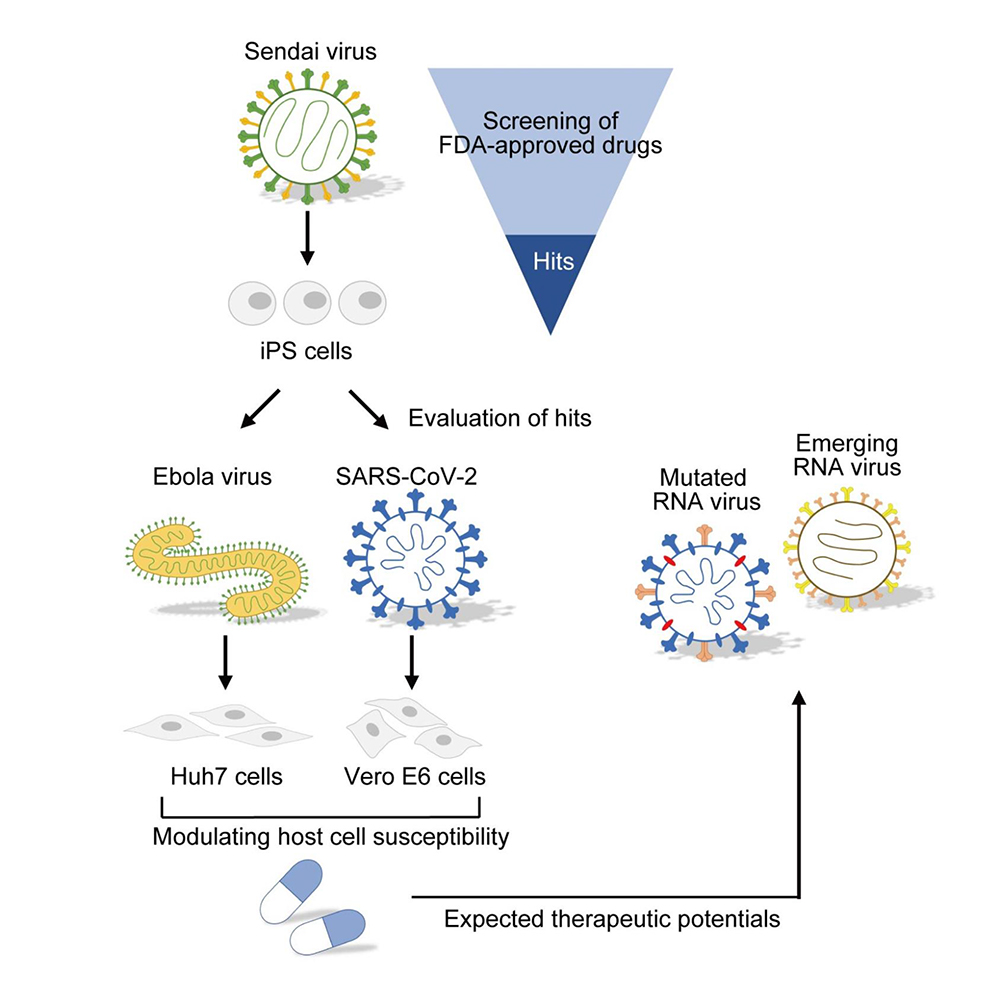
COVID-19:京大、新型コロナ薬候補発見:raloxifene、 pioglitazone(動画):
COVID-19:Kyoto Univ discovers drug candidate:raloxifene、pioglitazone:
COVID-19:京都大学发现新的电晕候选药物:雷洛昔芬和吡格列酮
ーiPS細胞研究で新型コロナ薬候補を発見ー
京都大や長崎大:
研究チームは、「iPS細胞を使って、新型コロナウイルス感染症の治療薬候補を見つける方法を開発した」と発表した。
「別の病気に使われる既存の薬」から絞り込んだ。
- 骨粗鬆症の薬や、
- 血糖を下げる薬などが、
- 効く可能性があるとしている。
新型コロナ感染症の治療薬:
各国で有効薬を探索中。
日本国内では:
ベクルリー(一般名レムデシビル)と、
デキサメタゾンが、承認されている。
WHOでは:
一方、世界保健機関は「ベクルリーの効果に否定的な見解」を示している。
世界各国で、有効な薬の探索が続いている。
ヒトiPS細胞を活用:
研究チームは、ヒトiPS細胞に薬をかけ、調査した。
「新型コロナウイルスと、遺伝子が同型であるセンダイウイルス」に着目した。
今回、このセンダイウイルスの侵入を、防げるかどうかを調べた。
その結果、薬品の効果を判定する方法を解明した。
ラロキシフェンやピオグリタゾン:
既存の薬について、500種類を調査した。
- 骨粗鬆症薬エビスタ(一般名ラロキシフェン)や、
- 血糖降下薬アクトス(一般名ピオグリタゾン)の効果が高いことがわかった。
感染防止効果を確認:
実際に、新型コロナウイルスを細胞に感染させる実験を実施。
これらの薬に。感染を防ぐ効果があることを確かめた。
朝日新聞デジタル
https://www.asahi.com/articles/ASP464HD7P42PLBJ008.html
RNAウイルスの感染を阻害する既存薬の同定
―複数の異なるRNAウイルスに対して宿主細胞の感受性を下げることにより感染を抑制する薬剤―
CiRA(サイラ) | 京都大学 iPS細胞研究所
https://www.cira.kyoto-u.ac.jp/j/pressrelease/news/210407-000000.html
CiRA | Center for iPS Cell Research and Application, Kyoto University
https://www.cira.kyoto-u.ac.jp/e/index.html
iPSC screening for drug repurposing identifies anti‐RNA virus agents modulating host cell susceptibility
iPSC screening for drug repurposing identifies anti‐RNA virus agents modulating host cell susceptibility
Keiko Imamura Yasuteru Sakurai Takako Enami Ran Shibukawa Yohei Nishi … See all authors First published: 06 April 2021
– FEBS Open Bio – Wiley Online Library
Abstract
Human pathogenic RNA viruses are threats to public health
because they are prone to escaping the human immune system through mutations of genomic RNA, thereby causing local outbreaks and global pandemics of emerging or re‐emerging viral diseases.
While specific therapeutics and vaccines
are being developed, a broad‐spectrum therapeutic agent for RNA viruseswould be beneficial for targeting newly emerging and mutated RNA viruses.
In this study,
we conducted a screen of repurposed drugs using Sendai virus (an RNA virus of the family Paramyxoviridae),with human‐induced pluripotent stem cells (iPSCs) to explore existing drugs that may present anti‐RNA viral activity.
Selected hit compounds
were evaluated for their efficacy against two important human pathogens:
Ebola virus (EBOV) using Huh7 cells
and severe acute respiratory syndrome coronavirus 2 (SARS‐CoV‐2) using Vero E6 cells.
Selective estrogen receptor modulators (SERMs), including raloxifene,
exhibited antiviral activities against EBOV and SARS‐CoV‐2.
Pioglitazone, a PPARγ agonist, also exhibited antiviral activities against SARS‐CoV‐2,
and both raloxifene and pioglitazone presented a synergistic antiviral effect.
Finally,
we demonstrated that SERMs blocked entry steps of SARS‐CoV‐2 into host cells.These findings suggest that
the identified FDA‐approved drugs can modulate host cell susceptibility against RNA viruses.
Abbreviations
DAPI 4’6‐diamidino‐2‐phenylindole
EBOV Ebola virus
EGFP enhanced green fluorescent protein iPSCs induced pluripotent stem cells
MOI multiplicity of infection
SARS‐CoV‐2 severe acute respiratory syndrome coronavirus 2
SERMs selective estrogen receptor modulators
VSV vesicular stomatitis virus
ZIP zero interaction potency
https://febs.onlinelibrary.wiley.com/doi/10.1002/2211-5463.13153